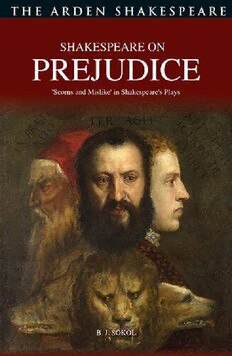
Shakespeare on Prejudice: ‘Scorns and Mislike’ in Shakespeare’s Plays PDF
321 Pages·2022·1.946 MB·English
Most books are stored in the elastic cloud where traffic is expensive. For this reason, we have a limit on daily download.
Preview Shakespeare on Prejudice: ‘Scorns and Mislike’ in Shakespeare’s Plays
Description:
How are various forms of prejudice portrayed in the works of Shakespeare and to what extent does Shakespeare differ from his contemporaries in their portrayal? What can we learn about Shakespeare's times and our own through a close reading of prejudice depicted in his plays?In this rich study, B. J. Sokol examines Shakespeare’s repeated dramatic portrayals of prejudice in action, a prejudice stemming from deeply rooted dislikes and targeted at five distinct areas: education, the arts, peace, ‘strangers’ or outsiders, and sexual love. Through a close reading of his plays, comparison with the works of other Elizabethan writers and a consideration of Shakespeare's social environment, the study provides a detailed appreciation of Shakespeare's dramatic method and how these prejudices feature in his work.In considering prejudice against education, Sokol examines Shakespeare's numerous representations of pupils, teachers and schooling, focusing on anti-educational prejudices in The Merry Wives of Windsor and in King Henry VI Part 2. The distaste of characters for art is considered alongside Shakespeare's repeated depiction of the destructive downgrading of the arts that erupts during political upheavals, while prejudice against peaceful living is traced in Shakespeare's various portrayals of ‘honour’-driven feuding, such as in Romeo and Juliet, and in warrior characters such as Coriolanus. Prejudice against strangers as depicted in plays including Titus Andronicus, Othello and The Merchant of Venice is contrasted with that of plays by his contemporaries, including Marlowe’s The Jew of Malta, while a final chapter examines prejudice against sex and the representation of many male and female characters who evade the erotic, subordinate the erotic to power seeking, or regard their own or others’ erotic attachments with revulsion.
See more
The list of books you might like
Most books are stored in the elastic cloud where traffic is expensive. For this reason, we have a limit on daily download.
